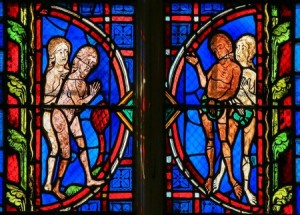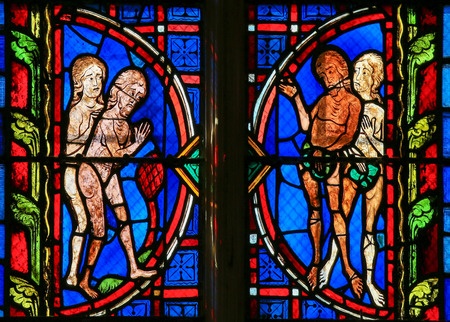
In the second book of his space trilogy, Perelandra, C.S. Lewis described how the Eden-like world of Venus was defended against an invading satanic character who attempted to get its “Adam and Eve” to disobey the clear command they had been given. Sound familiar? It is an alternative history, if you will, of the story of the Fall in Genesis. It raised an important question to me: What would have happened if Adam and Eve had successfully withstood the temptation in the Garden? Would that have been the end of the assault against them?
The answer to that question has to begin with what Reformed theologians like Anthony Hoekema call an understanding of the image of God in its “full biblical content. ” In other words, we need to consider human nature in the context of creation, fall and redemption.
In the beginning, before the Fall, Adam and Eve were “able not to sin.” This original imaging meant that Adam and Eve functioned sinlessly and obediently 1) in worshipping and serving God; 2) in loving and serving each other; and 3) in ruling and caring for creation. Although they were sinless in their original state, Adam and Eve “were not yet fully developed image-bearers of God.” There was still the possibility of sin; they were also “able to sin.”
This original condition was the boundary or the edge of the image of God; it was provisional and temporary. Adam and Eve were created in the image of God, but they were not yet a finished product. Herman Bavinck said: “Adam . . . had the posse non peccare [able not to sin] but not yet the non posse peccare [not able to sin]. He still lived in the possibility of sin.” Adam could either “pass over into either a state of higher glory or into a fall into sin and death.”
Human beings created in the image of God are self-conscious, free, responsible, religious agents. They were made upright and holy, and would have continued as such if they had remained faithful to the demands upon them “by reason of God’s propriety in [them] and sovereignty over [them].” This state was one of “an intensified and concentrated probation.” According to John Murray, as long as they did not commit sin, they remained in possession of their original moral and religious status. If they had successfully withstood the time of probation, they would have left it behind forever.
This meant Adam and Eve were at the beginning of the road humanity was meant to travel, to use Herman Bavinck’s metaphor. Still ahead of them was both their Fall and Redemption in Christ. So we should understand the original state of human nature before the Fall as able to sin, able not to sin: posse peccare, posse non peccare. As a consequence of the Fall, we were not able not to sin: non posse non peccare.
Without the work of Christ, we would have remained in a state of total inability to avoid sin; eternally separated from God. But through the Redemptive work of Christ, we have the guaranteed gift of non posse peccare (not able to sin). Creation, Fall, Redemption. But our current state is one of “already, but not yet,” in that while Christ has already come with the promise and down payment of non posse peccare, He has not yet returned to fulfill that promise.
In a similar fashion, Augustine described the four states of a Christian’s life, beginning with that of non posse non peccare, not able not to sin. The first state is when he or she is sunk in the darkest depths of ignorance, living according to the flesh, and undisturbed by conscience or reason. The second state comes when knowledge of sin comes through the law. Since the Spirit of God has not yet begun its aid, humanity was thwarted in it efforts to live according to the law. And being overcome by sin, became its slave (2 Peter 2:19). The effect produced by the knowledge of the law is that now they have the additional guilt of willful transgression of God’s law.
The third state comes when the Spirit of God begins to work within a person. Although there is still the old nature of flesh that fights against them (for their disease is not completely cured), yet they live “the life of the just by faith,” and in righteousness as far as they do not yield to their lusts and desires, but conquer them by the love of holiness. The one who by steadfast piety advances in this course shall attain the peace that shall be perfected after this life is over—the repose of the spirit. And then they achieve the resurrection of the body. And this is the fourth state. “Of these four different stages the first is before the law, the second is under the law, the third is under grace, and the fourth is in full and perfect peace.”
Drawing on a graphic representation of human nature from Richard Gaffin, we have the following:
 Humanity before the Fall had the ability to sin or not sin. They were created in the image of God as self-conscious, free, responsible, religious agents even with regard to sin. After of the Fall they could not help but sin; it was now part of their nature. Without the redemptive work of Christ, humans can “be all they can be,” but they cannot transcend their fallen nature.
Humanity before the Fall had the ability to sin or not sin. They were created in the image of God as self-conscious, free, responsible, religious agents even with regard to sin. After of the Fall they could not help but sin; it was now part of their nature. Without the redemptive work of Christ, humans can “be all they can be,” but they cannot transcend their fallen nature.
Every intention of their heart is to do evil (Genesis 6:5). It seems to me that the consequence of death for disobeying God’s command was both a blessing and a curse. Without death from sin, humanity would have become devils—eternally existing as beings not able to not sin. But God’s plan was to send a Savior; someone who could save us from this body of sin and death: Jesus Christ (Romans 7:23-24). Through the finished work of Christ, we have the guarantee of the promised renewal of human nature when Christ comes again (Ephesians 1:13-14).
But what of our original questions? What if Adam and Eve had successfully withstood the temptation in the Garden? Would that have been the end of the assault against them?
Until they had received the gift of a new nature, one that was not able to sin, they would have continued to be vulnerable to temptation. And, I believe, continually assaulted. At some point, this probationary time for humanity would have ended with the coming of a Redeemer—someone who would save them from the ability to sin. Either way, God planned to save us from ourselves. So it would have been creation, ability to fall, redemption.
What would that redemption have looked like? We will never know in this state. Perhaps we will in the next. But what we do know is that we can trust God. In the alternative history of Pelandra, Lewis, speaking through the character of Ransom said:
Whatever you do, He will make good of it. But not the good He had prepared for you if you had obeyed Him. That is lost for ever. The first King and first Mother of our world did the forbidden thing; and He brought good of it in the end. But what they did was not good; and what they lost we have not seen.





